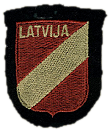19
July 10 and July 31, and neither of them said he was at Meierovics. The one witness who was at Meierovics did not see Hazners until August. So we are left with the question: where was Vilis Hazners during those three weeks?
2. Annas Street
The respondent has established that he started to work for the Annas Street headquarters soon after it was created by the German authorities. The government does not contest that fact; however it rejects the premise that Hazners' duties at Annas Street precluded his presence at the ghetto gate.
a. What was the Schutzmannschaft? 29/
The respondent repeatedly testified that there was no difference between the self-constituted Self-Defense Forces and the SS sponsored Kartibas Dienests. (tr. 1083, 1084, 1086, 1116, 1117, 1152, 11531) He also vehemently denied that the Kartibas Dienests was a police force. (tr. 10822) Hazners' reasons for putting distance between his organization and the SS in Latvia are not difficult to fathom: 1by characterizing the Kartibas Dienests as a purely Latvian group devoted to chasing partisans around the country, he removes any reason for his presence outside the gate of the Riga ghetto.
| 29/ | The Schutzmannschaft, the Kartibas Dienests, and the Annas (or Ann) Street Headquarters are one and the same. (Stipulation of May 17, 1979) The respondent uses a fourth term, Self-Defense forces, to refer to this organization, but they ceased to exist shortly after the German invasion, and 2application of the term to any organization which existed after August, 1941 is deceptive and misleading. |
Examination
At the core of the INS's attack on Hāzners is which titular groups either organized war crimes or a portion of whose members had committed war crimes.
The INS had no problems reaching out to German authorities in a panic during the proceedings to ask for information on the "RIGAER SCHUTZMANNSCHAFT" which could be provided on short notice, with apologies for requesting it during the Easter holidays. Moreover, per a cable requesting files similar to Hāzners' on other Waffen-SS officers, we know the INS had Hāzners's files in their possession. That the INS made no reference to Hāzners's documented war record proves the INS knew it cleared Hāzners. Nor should we be surprised, since German investigators had communicated two years prior to the INS filing charges that no evidence of war crimes had been found against Hāzners and that any actions had been suspended owing to lack of evidence.
The only possible conclusion is that the INS willfully ignored exculpatory evidence. Indeed, it eventually came to light that the INS had unconstitutionally withheld such evidence from the defense. But, then, deportation proceedings are not an actual court of law—which the INS clearly attempted to use to its advantage.
Hāzners's continued use of "Self-Defense" is consistent with the function of Veiss' command. What is "deceptive" and "misleading" is the INS's choice to ignore the specifics of Hāzners's service as documented in German records in their possession and to allege guilt by association instead.
| 1 | Testimony of Vilis A. Hazners, 9-March-1978, cross examination, transcript pp. 1061–1161. |
| 2 | Testimony of Vilis A. Hazners, 9-March-1978, cross examination, transcript pp. 1061–1161. |
